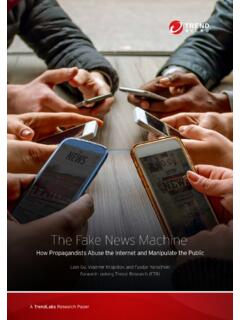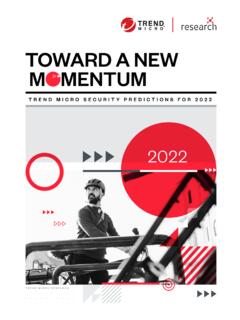Transcription of MAPPING THE FUTURE - documents.trendmicro.com
1 MAPPING THE FUTURED ealing With Pervasive and Persistent ThreatsTREND micro SECURITY PREDICTIONS FOR 2019 CONTENTS04 CONSUMERS08 ENTERPRISES15 SECURITY INDUSTRY18 INDUSTRIAL CONTROL SYSTEMS12 GOVERNMENTS23 SMART HOMES26 Getting Ready for the Year Ahead20 CLOUD INFRASTRUCTUREP ublished by Trend micro ResearchStock images used under license from MICROSECURITYPREDICTIONSFOR 2019In 2019 and beyond, the biggest trends expected to have an impact on technology and security are the advances in artificial intelligence and machine learning brought about by the ever-growing volume of data that can be processed and analyzed; the continued adoption of cloud computing by enterprises the world over; and the developments in smart devices, homes, and factories to say nothing of the looming 2020 rollout of 5G, the latest phase of mobile communications geared toward further increasing internet speeds.
2 Furthermore, 2019 will be an important year for political developments including the finalization of Brexit and the holding of landmark elections in several countries. These technological and sociopolitical changes will have a direct impact on security issues in 2019. Cybercriminals are expected, as usual, to home in on these movements, where the opportunity for profit is likely, fast, and relatively easy to navigate. In 2019, the implications of digital intrusions will be more far-reaching in terms of scope and consequence: Actual fraud using breached credentials will rise, more lives will be claimed as a result of sextortion, collateral damage will be observed as countries grow their cyber presence. Morever, the success of cyberpropaganda and fake news will have the power to decide the fate of nations.
3 Consequently for enterprises, new challenges will include the lack of skilled manpower, which will cause budget pressure as they seek expert IT security staff; outsourcing will increase. Also, cyber insurance will experience unprecedented growth, since penalties for breaches and noncompliance are also expected to grow. Our security predictions for the year ahead are based on our experts analysis of the progress of current and emerging technologies, user behavior, and market trends, and their impact on the threat landscape. We have categorized them according to the main areas that are likely to be affected, given the sprawling nature of the technological and sociopolitical changes under micro Security Predictions for 2019 CONSUMERSS ocial Engineering via Phishing Will Replace Exploit Kits as Attack Vector Cases of phishing will markedly increase in 2019.
4 Phishing attacks where an attacker pretends to be a reputable person or entity so they can lure someone into disclosing sensitive information have been around for a long time. But through the years threat actors have been finding ways to minimize user interaction in their conduct of cybercrime. Exploit kits, for example, gained popularity because they could automatically determine the relevant exploit to use on a target based on the victim s software versions. However, in recent years, the state of quasi-monoculture large communities of devices all running more or less the same software and operating systems (OSs) has been breaking down. Five years ago, Windows was king,1 but now no single OS holds more than half of the Cybercriminals have to make a choice: spend hours on exploits or campaigns that work only on a small chunk of the computing population and that software vendors can curb with a patch, or go back to the classic technique for which there had never been a reliable, lasting solution social engineering.
5 We will continue to see a decrease in exploit kit activity, something we have noted in our exploit kit activity 1. Exploit kit activity blocked decreased over the years, based on data from the Trend micro Smart Protection Network infrastructure as of Q3 attacks are picking up, based on our data feeds, and this rising trajectory will continue in ,414,2788,803,2311,120,883260,8036 Trend micro Security Predictions for 2019 CONSUMERSF igure 2. Phishing-related URLs blocked increased over the years, based on data from the Trend micro Smart Protection Network infrastructure as of Q3 will see phishing attempts not only in email but also in SMS and messaging accounts. Cybercriminals will target the usual online banking credentials, but they will also go after accounts used for cloud storage and other cloud services.
6 We will also see completely new types of attacks like SIM-jacking, which relies quite heavily on social engineering. In SIM-jacking, criminals impersonate a target and convince a phone carrier s tech support staff to port a lost SIM card to one they already own, effectively taking control of a target s online presence, which is often associated with one s mobile phone terms of socially engineered content, we foresee cybercriminals using real-world sporting or political events like the 2019 Rugby World Cup in Japan, the 2020 Summer Olympics in Tokyo, and the upcoming elections in different countries. Cybercriminals, for example, will create fake sites purporting to sell advance event tickets, deploy fake ads for free or discounted items, or send relevant election- or sport-related content that carry malicious Will Be AbusedOnline communication has expanded beyond email messaging.
7 As more tech-savvy and always-online youth use the internet, messaging apps have become a socially accepted channel between individuals or between an individual and a company rendering some form of online customer service or support. This new norm, combined with the preference for social engineering discussed earlier, will open new opportunities for predict that attacks abusing chatbots will become rampant in 2019. In the same way that telephone attacks evolved to take advantage of prerecorded messages and interactive voice response (IVR) systems, attackers will design chatbots that can hold an initial conversation with a target to create a convincing pretext for eventually sending over a phishing link or obtaining personal information. Attackers will explore a wide range of possible payloads, including manipulation of orders, installation of a remote access trojan (RAT) in the target s computer, or even ,063,49335,081,6488,164,348210,479,0267 Trend micro Security Predictions for 2019 CONSUMERSE-Celeb Accounts Will Be Abused in Watering Hole AttacksStill in line with the trend toward craftier social engineering tactics, cybercriminals will compromise famous YouTubers and other online-famous personalities social media accounts.
8 Cybercriminals will look for accounts that have several million followers and will work on taking over these accounts via targeted phishing attacks and the like. These attacks will shine a light on account security in mainstream media, but not before millions of users following these accounts have been affected by whatever payload the attackers have in store for them. The followers computers may be infected by infostealers or made to join campaigns for distributed denial of service (DDoS) or cryptocurrency mining. They may even have their accounts turned into troll Mass Real-World Use of Breached Credentials Will Be SeenA recent report by Ponemon Institute and Akamai highlighted that credential stuffing the automated injection of stolen username and password combinations from a single breach into several other popular websites is becoming more and more Because of the volume of data breaches in the past years and the likelihood that cybercriminals will find a lot of users recycling passwords across several websites, we believe that we will see a surge in fraudulent transactions using credentials obtained by cybercriminals from data breaches.
9 Cybercriminals will use breached credentials to acquire real-world advantages such as registering in mileage and rewards programs to steal the benefits. They will also use these accounts to register trolls on social media for cyberpropaganda, manipulate consumer portals by posting fake reviews, or add fake votes to community-based polls the applications are Cases Will RiseWe will see an increase in reports of teenagers and young adults being extorted for non-monetary reasons like sextortion. Even if there is no guarantee that a blackmailer will come through, the highly personal nature of this kind of attacks will make the victim seriously consider fulfilling the attacker s demands, whether that means money or sexual favors. As sextortion, in particular, becomes more widespread,5, 6, 7 this kind of attacks will affect, perhaps even claim, more lives in micro Security Predictions for 2019 ENTERPRISESHome Networks in Work-From-Home Scenarios Will Open Enterprises to BYOD-like Security RisksEnterprise IT will observe more and more attacks where the entry points are employees internet-connected home devices.
10 This is the unexpected but inevitable intersection of two trends: the rise of remote-working arrangements and the increasing adoption of smart devices in the home. More employees are taking advantage of the option of accomplishing work at home (aka telecommuting, mobile work, or work-from-home). As reported by Gallup, 43 percent of American employees were working remotely in 2016, up from 39 percent in And according to a global workforce survey conducted by Polycom, nearly two-thirds of employees took advantage of anywhere working in 2017, up from just 14 percent in Like BYOD (bring your own device), work-from-home challenges the visibility of enterprise data movements whenever employees use their home internet to access cloud-based apps and collaboration software for chat, videoconferencing, and file sharing.











